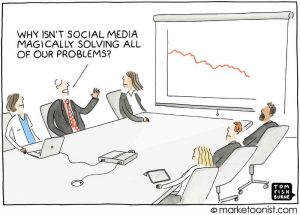Forget about predicting ROI in today’s lightning-fast digital environment. Instead, develop agile, reactive response systems.
The marketing team spent its budget dollars wisely. But management can’t see the results.
When business spends money on anything, it expects to see a “return on investment”— a lift that has some correlation with the spend. This would be fine if marketing was a machine, with fixed, measurable inputs and outputs. Except we are living in “the Information Age”, so Industrial Age accounting will fail to notice what is really going on.
Marketing often appears as a cost sink on the balance sheet. It’s relationship to output is not always obvious. Kathleen Schaub, marketing management and organization strategist, and Mark Stouse, chairman of Proof Data Corporation, want to shed some light on this situation. Schaub focuses on how complexity affects marketing, while Stouse takes a deeper look at analytics. These two angles converge on a common point: the old way of measuring marketing ROI misses a lot, providing inaccurate guidance for marketing efforts.
Schaub goes into further detail in her paper “Marketing Is Not a Vending Machine.” “Markets are what science calls complex adaptive systems. The interactions of many independent agents, both individuals and enterprises – customers, companies, influencers, partners, and governments, produce feedback loops that cause situations to constantly change. Change produces many unknowns.” Schaub wrote.
Those feedback loops have speeded up, thanks to globalization and digitalization. “There’s no breathing room,” Schaub told us, so marketers have a hard time keeping up. It is only in the past several decades that data and computers have finally provided a way to see this happening. “Now that things have speeded up, we can see these patterns in the data.”
“ROI for marketing is not there.” Schaub said. “Never has been. Never will be. Not in the old standard sense.”
The only thing certain is uncertainty
“The big shift, which is probably permanent, started with COVID,” Stouse said. “The feedback loops really matter,” Stouse continued. Now you needed to have a value goal, a route to value, and the ability to track your effort, much like a GPS, he said. This is running concurrently with the disintegration of third-party data.
To get a more realistic picture, some marketers are returning to an older technique: marketing mix modeling (MMM). This technique is more common among larger Fortune 500 companies, Stouse said. But it was too balky to make operational — too slow, too manual, too expensive, too hard to scale, and hard for people to understand.
Today, MMM is getting a second look. “Automation has eliminated many of these challenges to operationalizing analytics.” Stouse said. “MMM is rooted in multi-variable regression analytics, which is the fundamental underpinning of the scientific method.” And this is mainstream and well understood, he added.
Any change in analytics will also trigger a change in organization. “You cannot continue to have the same kind of rigid, command and control, hierarchical, siloed kind of organization and have these very rigid waterfall business processes. They are just too slow, too inhuman, they are barren of information, because information cannot flow to where it is needed,” Schaub said.
“I kept asking CMOs and CEOS, ‘can you do ROI yet?’” Schaub recalled. “The answer was always ‘no’”. They had workarounds, like attribution, and pushing marketing “down funnel” to help sales, “but at the end of the day, people have to give up the fantasy that it [marketing] can ever be completely predictable.” Schaub said.
People believe in cause-and-effect, that with enough data, the right strategy, the right work processes, or enough efficiency, they could figure things out, Schaub said. COVID crashed that belief system. To rebuild, analytics will help, but organizations will also have to re-align so that they can work better “in conditions that need our response as opposed to our ability to predict.” she said.
If you can’t predict, project
Businesses can still draft scenarios and craft projections, laying down an outline of how things are expected to happen. “Then you have to ‘fast follow’ as the future becomes the present, with latent, low-level re-calculation, so you can find out where you are relative to that projection.” Stouse explained.
Here Stouse compared marketing analytics with GPS. The destination is not a fixed ROI point reached by a certain date. Instead, the goal can be reached despite changes in traffic and necessary detours. Just as the GPS recalculates, the decisionmaker can also recalculate the market spend or rescale the project to better accommodate reality.
Like GPS, you need a driver who can make decisions and change course as needed. Here the marketer is at the wheel, advised by analytics, able to react to circumstances, seize opportunity, or reduce risks as needed, Schaub explained. This is need not be a single person, but will often be an agile, multi-disciplinary team which is quicker, smarter, more innovative, and which can foster human problem solving. “You build for the long term, but the only time you can act is now,” Schaub said.
Learning to live with speed
The speed of data, and feedback loops has increased tremendously, changing the digital landscape more quickly than a company’s capacity to comprehend and keep up.
Here the concept of the OODA Loop — Observe, Orient, Decide, Act — becomes relevant. The concept was coined by fighter pilot Col. John Boyd, who proved that if you can do this faster than your competitor, he will be stuck reacting to your last action as you execute your next move. “This is increasingly where business is and increasingly where marketing is,” Stouse said. “You have all these variables, and these variables are moving at a speed that the unaided human brain can’t track.”
“Being able to use software…compresses the OODA loop.” Stouse gave a real life example where his firm is working with a technology company. “This is a huge B2B enterprise tech company. It’s a long cycle business who has used MMM for six or seven years in a very traditional, conventional way.” he said. “[B]y the time the analytics reaches the marketing people, it’s so out of date that the prediction no longer matters…They don’t need to change the math. They need to change the speed at which it is all computed.”
As Schaub noted in her paper, a marketing department may have to track up to 30 variables to provide the insight needed to understand what present conditions are like. But it may not take as long as one might expect to pull them all together. Data automation can shorten the time it takes to weave insights from data streams.
“I don’t mean to imply that any of this is easy,” Stouse continued. “But it has significantly improved.” One can use tool sets like Supermetrics or Datorama (both Proof partners) to gather data streams, sanitize, cleanse and harmonize them, and then pipe the data into platforms like Proof or Tableau.
“We can go into a customer that has data but doesn’t have any analytical history at all…and the first 10 models can be up and running in less than 60 days.” Stouse said. Go to a traditional consultant doing MMM, and “it would be 10 to 12 months before you saw your first model.”
In the second part of this two part article learn why predictability and control are out, while perception and reaction are in.
The post Return on investment is missing in action appeared first on MarTech.
MarTech(14)
Report Post







